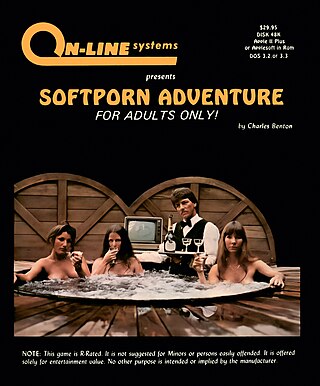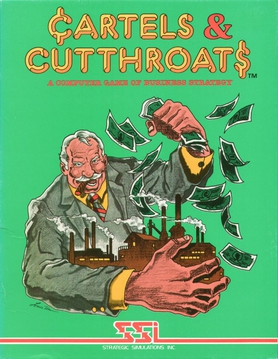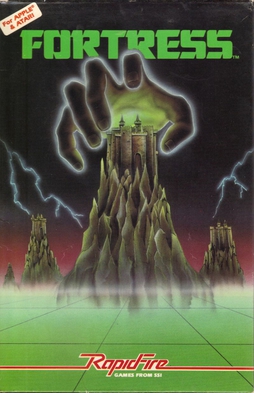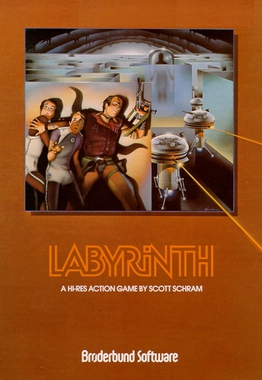
Choplifter is a military themed scrolling shooter developed by Dan Gorlin for the Apple II and published by Broderbund in 1982. It was ported to Atari 8-bit computers the same year and also to the VIC-20, Commodore 64, Atari 5200, ColecoVision, MSX, and Thomson computers.

Times of Lore is a 1988 action role-playing game that was developed and published by Origin Systems for several platforms, including PC, Commodore 64/128, ZX Spectrum, Amstrad CPC, Atari ST, Apple II, NES, and Amiga.

Roadwar 2000 is a 1986 video game published by Strategic Simulations, Inc. It is a turn-based strategy game set in a post-apocalyptic future which resembles the world portrayed in the Mad Max films.

Softporn Adventure is a comedic, adult-oriented text adventure game produced for the Apple II in 1981. The game was created by Charles Benton and released by On-Line Systems, later renamed Sierra On-Line. Years later, Softporn Adventure was remade and expanded as Leisure Suit Larry series of adult-oriented video games, and the first entry in that series, 1987's Leisure Suit Larry in the Land of the Lounge Lizards, was a nearly direct graphical adaptation of Softporn Adventure. Another graphical version was released as Las Vegas for various Japanese computers in 1986 by Starcraft.

Hi-Res Adventure #6: The Dark Crystal is a graphic adventure game based on Jim Henson's 1982 fantasy film, The Dark Crystal. The game was designed by Roberta Williams and was the first Hi-Res Adventure directly released under the SierraVenture label in 1983. Versions were published for the Apple II and Atari 8-bit computers. An alternate version of the game intended for younger players called Gelfling Adventure was released in 1984.

GATO is a real-time submarine simulator published in 1984 by Spectrum HoloByte for MS-DOS. It simulates combat operations aboard the Gato-class submarine USS Growler (SS-215) in the Pacific Theater of World War II. GATO was later ported to the Apple IIe, Atari ST, and Mac. In 1987, Atari Corporation published a version on cartridge for the Atari 8-bit computers, to coincide with the launch of the Atari XEGS.

Hacker II: The Doomsday Papers is computer game written by Steve Cartwright and published by Activision in 1986. It is the sequel to the 1985 game Hacker. Hacker II was released for the Amiga, Apple II, Apple IIGS, Amstrad CPC, Atari ST, Commodore 64, IBM PC, Macintosh, and ZX Spectrum.

The Prisoner is a 1980 Apple II computer game produced by Edu-Ware. The game was loosely based on the 1960s television series The Prisoner and incorporates that show's themes about the loss of individuality in a technological, controlling society. The player's role is that of an intelligence agent who has resigned from his job for reasons known only to himself, and who has been abducted to an isolated island community that seems designed to be his own personal prison. The island's authorities will use any means—including coercion, disorientation, deception, and frustration—to learn why their prisoner has resigned, and every character, location, and apparent escape route seem to be part of a grand scheme to trick the player into revealing a code number representing the prisoner's reason for resigning. The game occasionally breaks the fourth wall by acknowledging that a game is being played.

Test Drive is a racing video game developed by Distinctive Software and published by Accolade, released in 1987 for the Amiga, Atari ST, Commodore 64, and DOS, in 1988 for the Apple II, and later ported for the PC-98 in 1989. It is the first game in the Test Drive series.

Transylvania is an adventure video game published by Penguin Software. It was released for the Apple II in 1982 followed by ports to the Atari 8-bit computers and Commodore 64. A Mac conversion was published in 1984, then versions for the Amiga, Atari ST, and MS-DOS in 1985.

Sargon III is a computer chess program. It is a sequel to Sargon II.

Chronicles of Osgorth: The Shattered Alliance is a 1981 computer wargame published by Strategic Simulations in January 1982 for the Apple II and Atari 8-bit computers. Programmed by John Lyon, it relies on a new game engine, called RapidFire, intended to make faster and easier access to wargames published by the studio. During a turn, the program selects the units each in turn and the player only has to order them to move, attack or cast a spell. The order is then executed immediately before the program selects another unit. The game offers two categories of scenarios. The first is composed of medieval-fantasy confrontation, including a free adaptation of the Battle of Gondor against the Mordor forces in the Lord of the Rings. The second is composed of historical battles of antiquity.

Mickey Mouse: The Computer Game, also known as just Mickey Mouse, is an action game developed and published by Gremlin Graphics in 1988 for the Amiga, Amstrad CPC, Atari ST, Commodore 64, and ZX Spectrum.

Adventure in Time is a text adventure written by Paul Berker for the Apple II. It was published in 1981 by Phoenix Software, followed by a version for Atari 8-bit computers in 1983.

Cartels & Cutthroats is a 1981 video game published by Strategic Simulations.

Fortress is a video game published by Strategic Simulations in 1983 for the Atari 8-bit computers and Apple II. It was written by Jim Templeman and Patty Denbrook. A Commodore 64 port followed in 1984.

Objective: Kursk is a 1984 computer wargame designed by Gary Grigsby and released by Strategic Simulations in 1984.

A.E. is a fixed shooter written by Jun Wada and Makoto Horai for the Apple II and Atari 8-bit computers and published by Broderbund in 1982. Versions followed for the VIC-20 (1983) and MSX (1984). Unlike most earlier shooters which have a solid color or starfield as a background, the action in A.E. takes place in front of science fiction scenes. Attacking creatures emerge from points in the image, often appearing to come from behind objects. Combined with a slight scaling as they advance, there is the impression of depth.

Labyrinth is a maze shooter written by Scott Schram for the Apple II, published in 1982 by Broderbund. It was ported to the Atari 8-bit computers by Corey Kosak.

Threshold is a space-themed fixed shooter written by Warren Schwader and Ken Williams for the Apple II and published by On-Line Systems in 1981. Inspired by Sega's Astro Blaster arcade video game, Threshold introduces many enemy ship types and wave formations as the game progresses. Reviewers found the variety distinguished the game from the many similar shoot 'em ups.





















